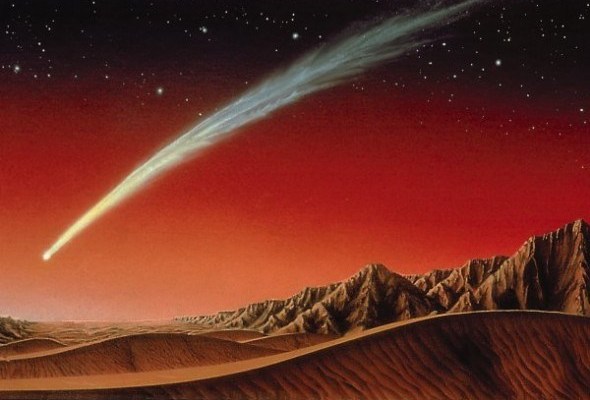|
By Nate Posey
Speculative fiction has given rise to a breathtaking array of possible futures, ranging from galaxy-spanning empires to tragic self-annihilation. Such timelines diverge from one another through a myriad of technological advances and geopolitical maneuvers, but there is one event which has been accepted as practically inevitable in humanity’s near future: a manned mission to Mars. The red planet has weighed heavily on the imaginations of science fiction writers for decades. While earlier treatments of mankind’s first contact such as Ray Bradbury’s The Martian Chronicles (1950) and Robert A. Heinlein’s Stranger in a Strange Land (1961) exploited the then total ignorance of conditions on Mars to paint fantastic, surreal accounts of advanced Martian civilizations, later works used the extensive findings of remote probes as the basis for a more sober account. My favorite telling is Ben Bova’s Mars, a novel which tracks the expedition of geologist Jamie Waterman and his international crewmates from the heights of Olympus Mons to the depths of the Valles Marineris with Bova’s characteristically impeccable attention to detail. The supreme confidence of speculative fiction writers in this “near future” event has both shaped and been shaped by the corresponding certainty within society’s popular imagination. Only modest extrapolation from the robust advances of the 1960’s in manned spaceflight was required to regard a Mars mission as plausible, if not outright inevitable, in a matter of years. For over a generation, the question has not been if, but when. Here in the year 2013, however, I cannot help but wonder: when indeed? The first practical mission plan for a manned Mars expedition was produced by Werner von Braun in 1948 and published in Collier’s Magazine in 1952. Von Braun, who would go on to design the signature Saturn V rocket of NASA’s Apollo program, remained a key collaborator on subsequent Mars mission proposals as part of Richard Nixon’s Space Task Group. Even as recently as 2004, President George W. Bush reaffirmed the priority of a manned Mars mission as part of his Vision for Space Exploration. As Von Braun’s initial proposals demonstrated, the technology and infrastructure necessary for such a mission has long been at our disposal; all that was needed was the will. And yet, time and time again, this will has failed to materialize. In 2010, President Barack Obama cancelled Bush’s program, scrapping the 2020 deadline for a return to the moon and pushing the long anticipated Mars mission into the ever more nebulous mists of the “near future.” This trend of delay and stagnation has served to cool the expectations of even diehard enthusiasts of the final frontier, and for some such as astrophysicist J. Richard Gott, it has even raised that most terrible of specters: the question of not when, but if. In his book Time Travel in Einstein’s Universe: The Physical Possibilities of Travel through Time, Gott describes the current epoch of manned spaceflight as a precious window of opportunity, a window that may be closing fast. He recounts the chilling story of the black Taj Mahal, a mausoleum which was to be constructed across the river from the existing Taj Mahal as a mirror image of sorts. Although Shah Jahan had ample resources on hand to undertake the project in 1653, he delayed. Five years later, he was deposed by his son Aurangzeb, and to this day the white Taj Mahal stands alone. Of course, even now, nothing stands in the way of the completion of this breathtaking marvel, but the necessary will has long since withered; the opportunity has been forever lost. Gott argues that a similar fate may await man’s oft-envisioned rendezvous with the red planet, and what now seems so inevitable may well be regarded by future generations as a mere historical curiosity, an opportunity lost in time.
0 Comments
Leave a Reply. |
Categories
All
Archives
April 2024
|

